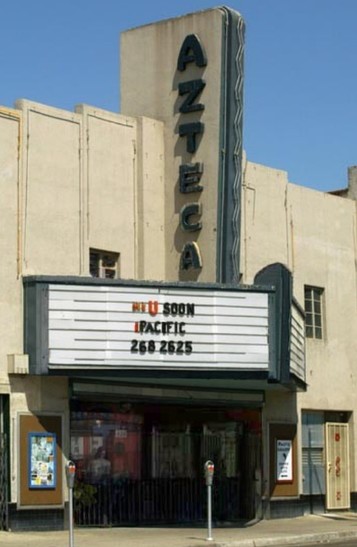Azteca Theater
Introduction
Text-to-speech Audio
The Azteca Theater was built in 1948 by Gustavo Acosta and was the first Spanish language theater in the San Joaquin valley. For much of the mid-twentieth century, the theater was a popular entertainment venue in Fresno, with many well-known Hispanic stars appearing in person or on the screen. The theater even served as a rallying point for Cesar Chavez and the National Farm Workers Association during the grape pickers’ strike in 1966. The two-story, Art Deco-style masonry building was restored in 2014 and was listed in the National Register of Historic Places in 2017. The theater currently functions as a movie theater, live music venue, and community events center.
Images
Front of Azteca Theater in 2006 photo (David L. Owens)

Front of Azteca Theater in 2016 photo for National Register (Karana Hattersley-Drayton)

New mural painted on rear facade of Azteca Theater (Hattersley-Drayton 2016)

View along center aisle of renovated auditorium to stage in 2016 (Laura Barboza)

Backstory and Context
Text-to-speech Audio
Gustavo Acosta opened the Azteca Theater (or Teatro Azteca in Spanish) on November 30th, 1948 and it quickly became an integral part of Hispanic culture in central California. It was the first Spanish language theater in the San Joaquin Valley and screened some of the most well-known Mexican films of the mid-twentieth century. The Art Deco style building was designed by Fresno's Johnson and Moore Consulting Engineers. The theater was built on an empty lot that had previously held the Congregational Chinese Mission by 1906. The two-story, brick building clad in stucco faced F Street with a stepped parapet and a vertical, fin-shaped neon "AZTECA" sign above a two-sided marquee. The recessed foyer entryway contained a hexagonal ticket booth and two side foyers for associated businesses in the side wings. The second floor featured four casement windows that lit mezzanine office spaces and bathrooms; similar windows on the rear facade lit dressing rooms. The auditorium had a wooden stage and no orchestra pit. The interior formerly was decorated with murals depicting Mexican and Aztec life.
In 1956, Acosta leased the theater to Arturo Romualdo Tirado (1912-1998), under whose guidance the venue continued to grow in popularity. Tirado, a Mexican immigrant, came to be nicknamed the "Mayor of West Fresno"; he previously managed a theater of the same name in San Bernardino. In addition to screening popular Mexican films, many of the leading Mexican actors of the period appeared at the theater. The theater was the only venue which catered to the area’s Mexican American community until the 1980s.
In 1966, the theater served as a rallying point for Cesar Chavez and the National Farm Workers Association as they marched from Delano to Sacramento. The farm workers sought an hourly wage of $1.40 and better working conditions. Because of its ties to agriculture, Fresno was one of the most important stops on the march, and roughly 1,000 people attended the rally at the Azteca. Reverend John McCarthy, a Catholic priest from San Francisco, prayed over the marchers; the program included hymns and Mexican revolutionary songs. Tirado arranged with the city for a police escort for the marchers as they traveled through Fresno. Chavez made other stops at the Azteca, including a visit to meet with Bobby Kennedy as he campaigned for the presidency in 1968.
Following Tirado’s retirement in 1980, the theater declined in popularity, began showing Kung Fu films, and then closed in 1986. In 1999, the decrepit, damaged building was purchased by David Owens and cleaned up; it reopened for special events and the lobby doubled as an art gallery that specialized in Chinese art. The vacant theater part of the building was restored by new tenants in 2014 as a movie theater, live music venue, and community events center. A mural celebrating the multi-ethnic heritage of Fresno's Chinatown was painted onto the rear of the building, facing China Alley, in 2016. Vintage theater seats were installed in the auditorium in 2016 to replace vandalized seating. In 2015, the Azteca was added to Fresno’s Local Register of Historic Resources. Two years later, the theater was added to the National Register of Historic Places.
Sources
ABC 30 Action News. Azteca Theater in Fresno's Chinatown being restored, Arts & Entertainment. September 24th, 2014. Accessed May 14th, 2024. https://abc30.com/azteca-theatre-in-fresnos-chinatown-being-restored/323440/.
Anonymous. "Priest Prays for Success of Marchers." Oakland Tribune (Oakland) March 25th, 1966. 9-9.
Azteca Theater (1948). A Guide to Historic Architecture in Fresno, CA. Accessed September 19, 2017. http://historicfresno.org/nrhp/azteca.htm.
Chacon, Estelle. "Enthusiastic Crowds Greet Trio Calaveras." The Daily Sun (San Bernardino) July 29th, 1953. 10-10.
Chinatown Fresno. Central CA's First Spanish Language Theater, Chinatown Fresno. January 1st, 2023. Accessed May 14th, 2024. https://www.chinatownfresno.org/properties-13/komoto%27s-department-store-%26-hotel.
Hattersley-Drayton, Karana. NRHP nomination of Azteca Theater, Fresno, California. National Register of Historic Places. Washington, DC. National Park Service, 2016.
Historic Fresno. Azteca Theater (1948), National Register of Historic Places. January 1st, 2017. Accessed May 14th, 2024. https://historicfresno.org/nrhp/azteca.htm.
https://en.wikipedia.org/wiki/Azteca_Theater_(Fresno,_California)#/media/File:Azteca_theater_fresno_2006.jpg
National Park Service (NPS): https://npgallery.nps.gov/AssetDetail/NRIS/100000779
NPS: https://npgallery.nps.gov/AssetDetail/NRIS/100000779
NPS: https://npgallery.nps.gov/AssetDetail/NRIS/100000779
